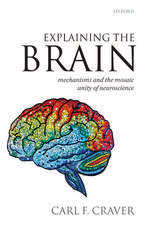Introduction to the Blood-Brain Barrier: Methodology, Biology and Pathology
Editat de William M. Pardridge MDen Limba Engleză Hardback – 27 aug 1998
| Toate formatele și edițiile | Preț | Express |
|---|---|---|
| Paperback (1) | 767.75 lei 43-57 zile | |
| Cambridge University Press – 13 dec 2006 | 767.75 lei 43-57 zile | |
| Hardback (1) | 1651.21 lei 43-57 zile | |
| Cambridge University Press – 27 aug 1998 | 1651.21 lei 43-57 zile |
Preț: 1651.21 lei
Preț vechi: 1738.12 lei
-5% Nou
Puncte Express: 2477
Preț estimativ în valută:
315.96€ • 330.72$ • 262.98£
315.96€ • 330.72$ • 262.98£
Carte tipărită la comandă
Livrare economică 31 martie-14 aprilie
Preluare comenzi: 021 569.72.76
Specificații
ISBN-13: 9780521581240
ISBN-10: 0521581249
Pagini: 502
Ilustrații: 150 b/w illus. 29 tables
Dimensiuni: 191 x 254 x 29 mm
Greutate: 1.23 kg
Ediția:New.
Editura: Cambridge University Press
Colecția Cambridge University Press
Locul publicării:Cambridge, United Kingdom
ISBN-10: 0521581249
Pagini: 502
Ilustrații: 150 b/w illus. 29 tables
Dimensiuni: 191 x 254 x 29 mm
Greutate: 1.23 kg
Ediția:New.
Editura: Cambridge University Press
Colecția Cambridge University Press
Locul publicării:Cambridge, United Kingdom
Cuprins
List of contributors; 1. Blood-brain barrier methodology and biology; Part I. Methodology: 2. The carotid artery single injection technique; 3. Development of the Brain Efflux Index (BEI) method and its application to the blood-brain barrier efflux transport study; 4. In situ brain perfusion; 5. Intravenous injection/pharmacokinetics; 6. Isolated brain capillaries: an in vitro model of blood-brain barrier research; 7. Isolation and behavior of plasma membrane vesicles made from cerebral capillary endothelial cells; 8. Patch clamp technique with isolated brain microvessel membranes; 9. Tissue culture of brain endothelial cells - induction of blood-brain barrier properties by brain factors; 10. Brain microvessel endothelial cell culture systems; 11. Intracerebral microdialysis; 12. Blood-brain barrier permeability measured with histochemistry; 13. Measuring local cerebral capillary permeability-surface area products by quantitative autoradiography; 14. Measurement of blood-brain barrier permeability in humans using indicator diffusion; 15. Measurement of blood-brain barrier permeability in humans with positron emission tomography; 16. Magnetic resonance imaging of blood-brain barrier permeability; 17. Molecular biology of brain capillaries; Part II. Transport Biology: 18. Biology of the blood-brain glucose transporter; 19. Glucose transporters in mammalian brain development; 20. Blood-brain barrier amino acid transport; 21. P-glycoprotein, a guardian of the brain; 22. Blood-brain barrier ion transport; 23. Ion channels in endothelial cells; 24. Interactions of lipoproteins with the blood-brain barrier; 25. Fatty acid and lipid intermediate transport; 26. Blood-brain barrier transport of drugs; Part III. General Aspects of CNS Transport: 27. The blood-CSF barrier and the choroid plexus; 28. Arachnoid membrane, subarachnoid CSF and pia-glia; 29. Circumventricular organs of the brain; 30. Transport in the developing brain; Part IV. Signal Transduction/Biochemical Aspects: 31. Regulation of brain endothelial cell tight junction permeability; 32. Chemotherapy and chemosensitization; 33. Lipid composition of brain microvessels; 34. Brain microvessel antigens; 35. Molecular dissection of tight junctions: occludin and ZO-1; 36. Phosphatidylinositol pathways; 37. Nitric oxide and endothelin at the blood-brain barrier; 38. Role of intracellular calcium in regulation of brain endothelial permeability; 39. Cytokines and the blood-brain barrier; 40. Blood-brain barrier and monoamines, revisited; Part V. Pathophysiology in Disease States: 41. Cerebral amyloid angiopathy; 42. Brain microvasculature in multiple sclerosis; 43. Hemostasis and the blood-brain barrier; 44. Microvascular pathology in cerebrovascular ischemia; 45. HIV infection and the blood-brain barrier; 46. Hypertension; 47. The blood-brain barrier in brain tumours; 48. The pathophysiology of blood-brain barrier dysfunction due to traumatic brain injury; 49. Cerebral malaria and the brain microvasculature; 50. Molecular basis of tissue tropism of bacterial meningitis.
Recenzii
"This book, introducing the essential methodologies, biology and pathology of the blood-brain barrier, is welcome, especially when edited by a known expert in the field, William M. Pardridge...recommended reading to those wishing to enter this challenging area of drug delivery" Journal of Controlled Release
Descriere
A comprehensive introduction to the blood-brain barrier and methodology of its study from international authorities.










